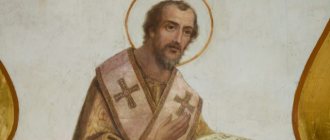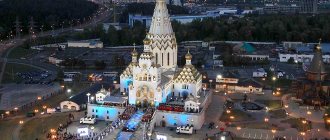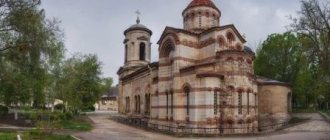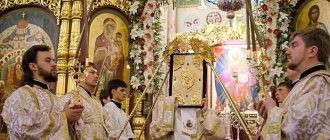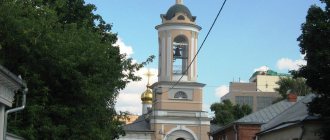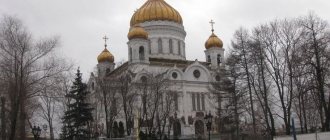In the very heart of old Yalta, where the Polikurovsky Hill rises, surrounded by a cypress park, there is the Church of St. John Chrysostom, for the construction of which the Governor-General of the Novorossiysk Territory M. S. Vorontsov personally petitioned. Construction began in 1835 and was carried out at state expense; the project was prepared by the architect G. I. Toricelli. The Orthodox shrine became the first structure made of stone and, in general, the first temple to appear in the resort city. The building can be easily seen from the sea, from the mountains and the Yalta valley.
© Larisa Kiseleva
The Church of St. John Chrysostom has nothing in common in appearance with traditional Orthodox churches; its appearance has echoes of English estates in the pseudo-Gothic style. Painting the walls in ocher shades, five hipped domes covered with gold leaf, the church bell tower, consisting of three tiers and becoming the main landmark of Yalta - this is how the church looked in those days. The building rose 45 m above sea level.
The cathedral was consecrated in 1837; a day later, Nicholas I and his wife arrived on Polikurovsky Hill.
In 1878, the shrine was rebuilt. A blue dome in the Byzantine style was added to the cathedral, and the expanded temple was crowned with a gilded cross. The territory of the church was also replenished with a parochial school. Over time, a city cemetery was formed next to the shrine, where many honored figures of science and art were buried. At the moment, a memorial necropolis has been founded on this site. During the years of Soviet power, the temple fell into disrepair; only in 1998, thanks to voluntary donations from city residents, it was restored to its original appearance. At the same time, a divine liturgy was held, led by Lazar of Crimea and the Archbishop of Simferopol.
While visiting the site, women should cover their heads; men may enter with their heads uncovered. You should not enter the shrine in overly revealing beach clothes.
Historians do not know the exact reason why the place was consecrated in honor of St. John Chrysostom. Today's rector, Archpriest Vladislav Schmidt, has several assumptions about this: firstly, the date of the consecration of the cathedral is close to the date of memory of the saint, secondly, not far from the temple there is a cape named in honor of this saint, thirdly, John Chrysostom proved himself as the founder of the Gothic Metropolis in Tauris.
© Larisa Kiseleva
Now the cathedral acts as a historical, architectural and geographical monument, and it is also a kind of symbol of the founding of the city. Work continues in the shrine to recreate the details of the decoration, and the ornamental painting of the 19th century is being restored. The restoration affected the chapel and church school, which were damaged during the war. The Cathedral of St. John Chrysostom is the most visited temple in Yalta; it is appreciated not only by local residents, but also by tourists, for whom a vacation would not be complete without visiting the famous shrine. There is a hotel for pilgrims at the church. At the entrance you can see a broken bell, found by parishioners and which is one of the bells of the old cathedral.
History of the Church of St. John Chrysostom in Yalta
This resort town was not always a “Crimean pearl”. Back at the beginning of the 19th century, Yalta was a small fishing village, where there were 13 modest houses on several streets.
But the situation changed radically when Vorontsov was appointed governor of the Novorossiysk Territory. A new chronicle of the city began in 1823: guests and high-ranking officials began to come to Yalta, which contributed to an increase in the population, the opening of new shops, a customs post, post office, and banks.
The strengthening of the city led to the growth of the Orthodox parish. Therefore, in 1832, Mikhail Vorontsov decided to build the Church of St. John Chrysostom in Yalta. The cathedral complex was erected in 1835, and on September 16, 1837, the building was consecrated.
The 80s of the 19th century were the time of reconstruction of the cathedral. Nikolai Krasnov, an outstanding city architect, was called to carry out work on the redevelopment of the prayer house.
He completely changed the design of the church - he expanded the premises, left one dome, which also changed the style of the building itself to Byzantine.
During the reign of the Soviets, the history of the Church of St. John Chrysostom was also darkened by persecution. In 1937, the church was officially closed, and the building of the cathedral complex was transferred to a food warehouse. During the Second World War, the belongings of German colonists who were evicted from their homes by the occupiers were brought to the temple.
1942 is the most tragic page in the annals of the house of worship. Unknown persons set fire to the church warehouse, which led to the complete destruction of the building. The ruins stood in the city until the 1950s, after which the site was cleared and given over to a clothing market.
The only thing that has survived from the Church of St. John Chrysostom is the high bell tower, which was not demolished due to its navigational significance. This structure has been marked on all existing nautical charts.
Only with the collapse of the Soviet Union did it become possible to restore the monastery. In 1994, Vladislav Schmidt, who is the current rector of the cathedral complex, initiated restoration.
The project for the future building was developed by Petrova, a Crimean architect, who found the original drawings of Toricelli (the creator of the cathedral) in the archives.
For the next three years, work was carried out to restore the Church of Chrysostom in Yalta. In the fall of 1998, the church was consecrated, and in 1999, Orthodox crosses were raised above the cathedral.
The history of the cathedral
The southern towns of the Russian Empire, after the influx of Christian population, acquired churches, and over time, rich cathedrals. Yalta was no exception. The Church of St. John Chrysostom proves that the first attractions here are not hotels and equipped beaches, but buildings with domes and bells. In churches, Orthodox people could communicate with God and the clergy.
1835 turned Yalta from a village of 13 houses, where the first settlers after the Turks lived, into a large village. It numbered several thousand inhabitants. The town had a pier, a market, a postal station, shops, a police station and a customs office. Only the church was missing. This deficiency was corrected in 1835 by the Novorossiysk governor M. Vorontsov with an iron will. The official found money in the state treasury to build a “house of God.”
The place for the construction was chosen well - the terrace of Polikurovsky Hill closest to the embankment, it was visible from all the central streets. The first architect was the Englishman Elson, but the work was completed by an Odessa resident of Italian origin, Torricelli, who “sculpted” the pseudo-Gothic temple, using limestone blocks for its construction. Workers cut them out of huge pieces of rock and then painted them yellow. The unusual building has long served as the main landmark of the historical center.
In the 80s the century before last, the Church of St. John Chrysostom was significantly rebuilt. After reconstruction, its building was expanded. The number of domes was reduced to one. Now it looked like a Byzantine basilica. In Soviet times, no stone was left unturned from this landmark of Yalta. The Bolsheviks banned divine liturgies everywhere. The temple complex received its previous appearance only in 1994 - one of the historians obtained Torricelli’s drawings from the archives.
Schedule of services in the Church of St. John Chrysostom
The current schedule of services and liturgies is published on the official website of the cathedral complex. It contains current data for each month of the year, indicating the days when liturgies are not supposed to be held.
Therefore, it is better to track the schedule on the portal or find out by phone at the help desk.
There is a Sunday school on the territory of the temple, where both children and adults can come. Classes are held on Sundays, and for preschoolers lessons are also organized on weekdays from 9:00 a.m. to 5:00 p.m.
As part of the Sunday school classes at the Church of St. John Chrysostom, not only a theological course is conducted, but also foreign languages are studied.
Parishioners can enroll in a handicrafts club and learn to play the piano. Particularly noteworthy are classes in spiritual and choir singing, a theater group, a fine arts studio and an early development class.
Sunday school at the temple
History of discovery
Today there is a Sunday school at the cathedral. It was built in 1898 according to the design of the architect N.P. Krasnova. The parochial school at the cathedral was named after Grand Duchess Olga Romanova, the eldest daughter of Tsar Nicholas II.
During the Great Patriotic War, the school building was destroyed. After the war, the building was dismantled for building materials by local residents.
Thanks to the efforts of the church parish, the school was restored in 2006 according to the previous design.
The interior design of the school delights with the beauty and richness of its architecture and modern interior design.
How does it work?
Children from five to sixteen years old are invited to study at the school. The following subjects are taught:
- foundations of Orthodoxy;
- singing;
- needlework.
The cathedral Sunday school also offers courses in many other areas:
- theological courses;
- preparing children for school;
- handicraft courses;
- sewing and clothing design courses;
- painting studio;
- choreography;
- ballroom dance club;
- performing arts studio.
In addition to classrooms, where children study in various clubs, the school also has a cafe-refectory, which serves delicious dishes. For believers who observe fasting days, delicious Lenten dishes are always available in the school refectory.
Since pilgrimage is the main part of the spiritual life of the Russian Orthodox Church, the church’s Sunday school operates a year-round “Shelter for Pilgrims.” This shelter is created for each person individually, and also operates for groups.
On the third floor of the school there are three comfortable rooms with shower and toilet, air conditioning and a refrigerator. Each room accommodates 4 people. Internet is available in the rooms.
During the summer season, additional rooms are equipped on the second floor of the school to receive guests who wish to combine a pilgrimage to the Orthodox shrines of the South Coast with relaxation. These rooms can accommodate 6 people.
In summer, groups of up to 25 people are accepted. During the rest of the year, up to 14 people are accepted. The shelter operates not only for adult pilgrimage groups, but also for children.
Sunday school teachers make great efforts to ensure that the life of the educational institution and parish is as rich and interesting as possible.
The main goals and objectives of children's Sunday school:
- raising children based on Christian principles;
- teaching the basics of the Christian faith;
- instilling church life skills;
- teaching children mutual assistance and understanding;
- development of creative abilities.
Parish of Chrysostom Church
St. John Chrysostom parish is a whole complex of buildings, which consists of a chapel, the temple itself and a Sunday school. On the school grounds there is a small shelter for pilgrims and a cafe-refectory.
On the territory belonging to the parish, there are church shops where guests of Yalta can purchase church utensils, souvenirs and Orthodox scarves. Also adjacent to the temple territory is an ancient cemetery, which thousands of tourists want to see.
It is also curious that in the territory of the parish of the Church of St. John Chrysostom in Yalta, Tatiana’s Day is revered on a special scale. In January, balls are held on the territory of the cathedral complex, and numerous thematic meetings of parishioners are also organized.
Architecture and decoration of the building
Let's look at the style in which the cathedral was built and how it is decorated inside.
Appearance
The temple is an architectural monument of the pseudo-Gothic architectural style. It is made in the pre-Romantic (or “Catherine”) style. The architecture of the cathedral combines features of European Gothic and Moscow Baroque.
The building of this beautiful church was the first cathedral church of Yalta. It was built from sawn blocks, which were eventually painted in the basic shades of an ocher palette. The cathedral is crowned with five domes covered with gold leaf.
The decoration of this building is also a bell tower with three tiers 45 meters high. It is the first structure built from stone.
Near the walls of the cathedral there is also a broken ancient bell, donated by grateful parishioners.
Interior design
Inside, the cathedral consists of a majestic iconostasis and many icons made in Odessa under the direction of the master Ignatius Poluinky.
Believers from Greater Yalta bring many icons.
How to get there?
The Church of St. John is located at the address: Yalta, Tolstoy Street, 10. You can get to the holy monastery in various ways, the simplest and most popular are:
- Travel by city bus. You should take route No. 6, 18A, 21, 22 or 47. Buses go to Yubileiny Square, where the Clothing Market stop is located.
- Walking tour. As part of an excursion tour of Yalta, many tourists decide to walk to the Church of St. John Chrysostom on their own. The starting point of the route is the Lenin monument, standing on the main promenade of the city - the embankment. From the monument you need to turn onto Roosevelt Street and walk along it towards the marine terminal. Having reached the “sea harbour”, you should walk past the chapel of St. Nicholas, then go up to Tolstoy Street and turn right. Near the restaurant “Yard at the Pier” the temple ensemble is located.
Contact information and opening hours
Address of the religious organization: 298600, Russia, Republic of Crimea, Yalta, st. Tolstoy, 10.
Entry to the temple grounds is free.
Opening hours: from 10:00 to 17:00. The cathedral may be closed for cleaning from 13:00 to 14:00.
The Holy Monastery of John Chrysostom is a unique structure that amazes with its beauty, aesthetic forms, and splendor of the interior. It is cozy and warm here at any time of the year.
Used materials
- Monastery page on the official website of the Abkhaz Orthodox Church:
- “Koman shrines”, page on the official tourism website of the Republic of Abkhazia:
- Monastery of St. John Chrysostom on the website "People's catalog of Orthodox architecture"
- Church of the Holy Martyr Basilisk on the website "People's Catalog of Orthodox Architecture"
Kremenetsky A.S., priest. Place of blessed death and burial of St. John Chrysostom and the Basilisk-Chrysostom Monastery in Abkhazia. Voronezh, 1908. P. 23
Dorotheus (Dbar), Hierom. History of Christianity in Abkhazia in the first millennium. New Athos, 2005. pp. 152-153. Note
D. V. Zaitsev. "John Chrysostom. Part II. Reverence." Orthodox Encyclopedia, vol. 24, p. 205-250 —
Where to stay in Yalta?
If you want to relax next to a pine forest, enjoy the healing juniper air, and dissolve in a comfortable and tranquil environment even in high season, book one of the 10 luxurious rooms at the Pallasa Boutique Hotel.
A Russian bathhouse made of Karelian logs, a fireplace, rare antiques, a fitness room, a plunge pool and an outdoor jacuzzi, a restaurant with original cuisine - we are sure that you will be able to relax here, both soul and body.
To contact the hotel administration, just dial +7-978-97-05-500 - the manager will tell you in more detail about the booking conditions and current prices.
The first Yalta Cathedral made of stone
The construction of the building, the first stone church of the city, was carried out with the active assistance of the Crimean philanthropist and governor of Novorossiya - Count Vorontsov, who left behind a great cultural heritage throughout the peninsula. It was thanks to the construction of this temple that Yalta immediately received the status of a city.
The architectural style in which the Church of St. John Chrysostom was built in Yalta is called pseudo-Gothic. At that time it housed English country houses and villas. The outer walls, made of sawn limestone blocks, were plastered and painted in ocher shades, and the main decoration of the temple were five domes covered with gold leaf, clearly visible from the sea and the Yalta valley.
The three-tiered bell tower, which once became the main navigational landmark for sailors and city planners, deserves special attention. Its height above sea level is 45 meters! However, in general, the image of the church does not resemble typical Orthodox buildings, especially after it was rebuilt at the end of the 19th century and a blue dome was added to the architectural group, made in the Byzantine style, crowned with a gilded cross.
Today the church is as magnificent as it once was, it is active - services are held there. The parish school has been restored.
Watch an overview video about the Church of St. John Chrysostom:
Legends about the temple
Yalta keeps many myths. The Church of St. John Chrysostom, judging by the legend, was named so for a reason. "Polykur" is translated from Greek as "Staroselie". This is exactly the name given to the Yalta hill, towering above the sea, where fishermen have long lived. And their patron was John. They named one local cape after him, and the Russians, who came here later, found out about it.
They also found the ruins of an Orthodox church, built by the Greeks and then destroyed during countless wars. When exploring those ruins, they also discovered fragments of a marble icon - the head of Jesus. The Tatar toponym was ignored - the Russian settlers also consecrated their first church, built in a completely different place, in honor of the Chief Apostle John.
When was it built
The project for the future cathedral arose in the early 30s of the 19th century, the initiator was Count M. Vorontsov, who held the post of governor-general of the region, and G. Torricelli was appointed as the architect.
The grand opening took place in September 1837. Thanks to the majestic building in the pseudo-Gothic style, which is a temple with five domes and a three-level bell tower, it was in 1837 that Yalta received city status.
The history of the temple does not end there. In the 80s of the 19th century, the temple was modified. Instead of five domes, the building is crowned with a sky dome in the Byzantine style with a golden cross, created by the architect N. Krasnov. The building itself was expanded and could now accommodate 750 parishioners at a time. In this form, the cathedral did not stand for long, and already in the 30s it was burned, and in the 50s it was completely dismantled. Only the bell tower remained untouched, and only due to its navigational status.
You might also be interested in learning about what the Roffe baths in Yalta look like, where they are located and what they are.
New church on Polikurovsky Hill
In November 1994, Archpriest Vladislav Schmidt received instructions from the hierarchy to build a new Church of St. John Chrysostom on the old ashes, in which he was to become rector.
The project was headed by the architect Alexandra Petrova, who requested drawings from the archives of the Vorontsov Palace in Alupka of the old design of the Toricelli church and took them as the basis for the new temple. Alexander Rubel from Simferopol became the engineer of the cathedral church.
The task ahead was difficult, there were not enough funds for construction, but thanks to the general director of Artek, Vitaly Shevchenko, and caring Orthodox builders who took up the work for a purely symbolic fee, Vladislav Schmidt managed to build the temple in three years.
In terms of architecture, the new pink and white temple repeated the features of the pseudo-Gothic five-domed church built during the time of Governor General Mikhail Vorontsov. The shrine was built with donations collected by active religious pensioners: women went to various organizations and literally begged caring people to provide all possible assistance to the temple.
During the restoration of the bell tower and the construction of the temple, the clergy of the church made several processions from the Church of Alexander Nevsky to Polikurovsky Hill, on which the shrine was erected. On November 26, 1996, a solemn ceremony of laying the first stone took place, led by Archbishop Lazar.
On November 26, 1997, the first Divine Liturgy in many years was celebrated in the unfinished Church of St. John Chrysostom. The ceremonial consecration of the temple took place on November 26, 1998.
This begs the question of why all the significant events in the new church took place on November 26th. The answer is simple. On November 26, the Russian Orthodox Church celebrates the day of remembrance of the righteous Saint John Chrysostom, therefore for the temple that bears his name, this date is a patronal holiday.
Golden consecrated crosses were raised over the Church of St. John Chrysostom at the end of December 1999.
Historical aspect
September 12 is the day of the consecration of the throne. 2021 marks the 180th anniversary of this memorable day. Ceremonial events are planned from July this year.
By the way, the very next day, September 17, old style, Nicholas I visited Yalta with his family, and, influenced by what he saw, including the Temple, 6 months later he issued a decree giving Yalta the status of a city. Active development according to the approved plan began only 5 years after the landmark decree.
It will also be useful to learn about what a tourist can see in Yalta in one day.
Interestingly, the temple was the heart of Yalta for a long time. Architect F. Elson, planning the urban development of Yalta, chose the cathedral as the starting point and from it, like arteries, the streets of the city diverged.
Shelter for pilgrims
In the building of the Sunday school there is a so-called hotel for Orthodox pilgrims, reservations for which must be made a month before the expected check-in. The hotel is called: “Shelter of Pilgrims.”
The Orthodox hotel has comfortable 3-bed rooms, as well as 4 and 5-bed economy class rooms.
Applications are accepted both individually and in groups. Payment for accommodation is made through a fixed donation. Phone for information.
For pilgrims, the hotel operates a café-refectory, the menu of which always includes Lenten dishes if believers are fasting.
Transfer services are provided for pilgrimage groups.
